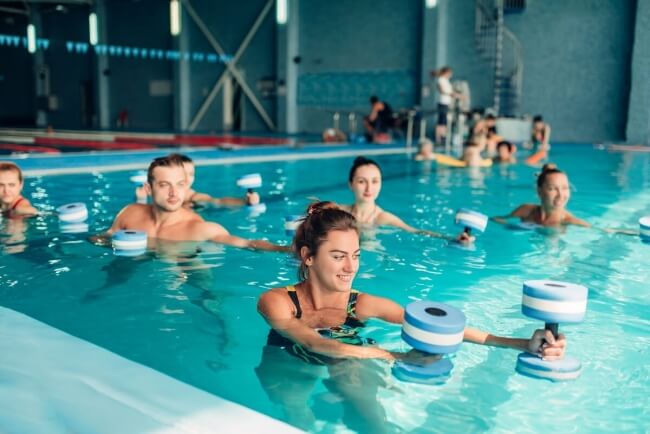
It’s no secret that joint pain affects millions. According to the Arthritis Foundation, roughly 54 million adults in the U.S. suffer from joint pain caused by arthritis alone, a number that only includes doctor-diagnosed cases. Countless others remain undiagnosed…and untreated. Most rely on over-the-counter medications and sheer willpower to make it through each agonizing day. Severe and chronic joint pain sufferers often resort to more serious medications, such as opioids (i.e. Hydrocodone, fentanyl, oxycodone, etc.).
There is, however, a proven alternative to not only help manage symptoms of joint pain, but also help to preserve the health of deteriorating joints.
How does exercise help with joint pain?
Exercise may seem counterintuitive when you are dealing with tired, aching joints, but it may be just the thing your body needs. In fact, avoiding physical activity can actually worsen symptoms and may lead to irreversible joint deterioration.
A tailored regimen of specific exercises and physical therapy can help to:
- Restore range of motion
- Strengthen muscles surrounding joints
- Protect joints from further damage
- Maintain bone strength
- Improve balance
- Assist in maintaining a healthy weight
- Enhance your quality of life
Exercises for Achy Joints

There are a variety of exercises used in the treatment of joint pain. Below are some examples to help get you started!
- Range of Motion Exercises – Relieve stiffness and increase the flexibility of your joints with daily routines. Your doctor or therapist can help you determine the appropriate techniques based on your needs.
- Strengthening Exercises – Strength training helps to strengthen the muscles that support and protect your joints. Be sure to talk to your doctor before starting a strength-training program and always listen to your body! When your joints are painful or swollen, they need to rest.
- Aerobic Exercise – Aerobic or endurance exercises play a significant role in maintaining cardiovascular health, weight, stamina, and energy. Low-impact aerobic exercises such as walking, bicycling, swimming, or using an elliptical machine are a great way to get your blood flowing without putting too much pressure on your joints.
- Aquatic Therapy – Aquatic Therapy, or “water therapy”, is an excellent way to increase mobility, strength, and flexibility. While the buoyancy of water takes some of the weight off the joints, it also provides the resistance needed to help build strength.
- Yoga – Practicing yoga regularly can reduce joint pain, improve joint function, build strength, and reduce tension. Be sure to talk to your doctor about limitations and poses you should avoid.
- Stay Active – Keep your body moving with daily activities such as walking to the mailbox, raking leaves, or walking the dog. *Again, listen to your body and avoid activities that cause additional pain.
*Depending on your condition and activity levels, some exercises may work for you while others can do more harm than good. Talk to your doctor or physical therapist about creating an exercise routine that’s best for your body.
How can I protect my joints when exercising?
Always ease your body into a new exercise routine, especially after an inactive period. Start slow and increase exercise length and intensity as your body allows.
The following tips can help you get started.
- Stick with low-impact exercises.
- Apply heat for up to 20 minutes to relax joints and muscles.
- Use gentle, movements. Don’t force it.
- Listen to your body. If you feel sharp pain or notice any redness or swelling, take a break.
- Apply ice to your joints for up to 20 minutes after activity, especially if you notice any swelling.
Soreness is normal after exercise, but if it persists longer than a couple hours, you may need to lower the intensity of your activity. Talk to your doctor if you notice any pain out of the ordinary.
 The Joint Preservation Center at Towson Orthopaedic Associates offers an innovative, personalized approach to long-term joint health. Utilizing early diagnosis, intervention, and the latest techniques, our orthopaedic surgeons can restore and preserve the joint’s natural ability, which makes it possible to avoid more invasive surgeries and prolonged rehabilitation. Are you suffering from persistent joint pain or stiffness? Call 410-337-7900 to schedule an evaluation or click here to learn how we can help preserve or restore the health of your joints.
The Joint Preservation Center at Towson Orthopaedic Associates offers an innovative, personalized approach to long-term joint health. Utilizing early diagnosis, intervention, and the latest techniques, our orthopaedic surgeons can restore and preserve the joint’s natural ability, which makes it possible to avoid more invasive surgeries and prolonged rehabilitation. Are you suffering from persistent joint pain or stiffness? Call 410-337-7900 to schedule an evaluation or click here to learn how we can help preserve or restore the health of your joints.

